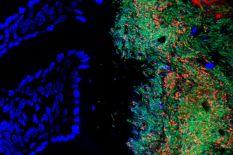CeMESS Secures €2.1M FFG Funding for Advanced Microbiome Imaging Equipment

The Centre for Microbiology and Environmental Systems Science (CeMESS) at the University of Vienna proudly announces a significant milestone: securing approximately 2.1 million Euros in funding from the Austrian Research Promotion Agency (FFG) Infrastructure Call 2022. This generous support will facilitate the acquisition of two cutting-edge lab instruments that promise to revolutionize the Centre's microbiome imaging capabilities.
Microbiome imaging, the visualization of microorganisms in their native habitats, provides invaluable insights into their composition and function. Through it, researchers can unlock answers to crucial questions on the ecology of microbial communities, with potential applications in health, industry, and environmental protection. Enhanced instruments allow for more detailed, accurate imaging, bringing us closer to understanding the intricate micro-world that significantly impacts planetary health.
Headed by researchers Holger Daims, Michael Wagner, Arno Schintlmeister, and Markus Schmid, and supported by Annina Müller Strassnig, the team will be procuring a state-of-the-art super-resolution confocal laser scanning microscope (CLSM) that promises to elevate the Centre’s fluorescence imaging capabilities. Notably, this CLSM will facilitate multicolour imaging with an extensive range of fluorescent dye combinations and highly efficient autofluorescence filtering.
"Our pursuit of knowledge in microbiome research hinges on our ability to see the unseen,” remarked Holger Daims. “With the super-resolution confocal laser scanning microscope, we're venturing into new frontiers of fluorescence imaging.” The new microscope will make formerly daunting challenges, such as fluorescence in situ hybridization (FISH) in soil, increasingly feasible. CeMESS scientists can now look forward to detailed visualizations of fluorescence-labelled microbial cells, viruses, and even protein complexes.
But that's not all. The team will also acquire a mid-infrared photothermal (MIP) spectrometer. This innovative chemical imaging technique was recently tailored for microbiology by CeMESS members in collaboration with the Cheng group from the Photonics Center at Boston University (US). With the capability to perform high-throughput, single-cell imaging of stable isotope composition, and non-fluorescent reporter molecules, the MIP presents unprecedented opportunities. Furthermore, it offers compatibility with FISH and other fluorescence labelling tools, enriching the breadth of its applications.
"Imagine gaining the ability to observe, at a cellular level, how microbiome members react to environmental perturbations or assimilate different nutrients. That's the potential we're looking at with these advanced instruments," added Michael Wagner, another key figure in the initiative and Vice Director at CeMESS.
Once installed, these state-of-the-art instruments will seamlessly integrate with CeMESS's existing fluorescence and chemical imaging equipment array, including the NanoSIMS, SRS, conventional Raman spectrometers, and a set of fluorescence microscopes. As a collective, this arsenal will forge a world-class microbiome imaging platform that will also provide exciting new opportunities for the members of the recently funded FWF-Cluster of Excellence “Microbiomes Drive Planetary Health” that is coordinated at the Centre.
With a planned installation of the new CLSM in early 2024, followed by the MIP, CeMESS remains committed to pioneering advances in microbiology and environmental systems science.
Photo: bacteria in the mouse gut stained in different colors by fluorescence in situ hybridization (credit: Alessandra Riva)
